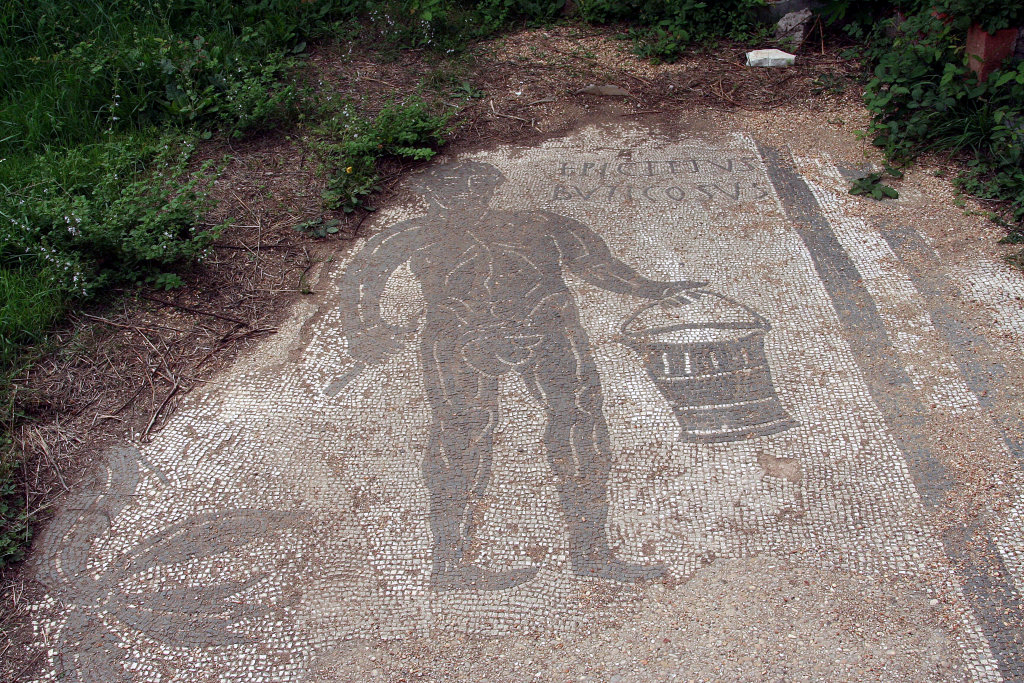The Baths of the bathing attendant Epictetus Buticosus were built during the reign of Trajan (opus mixtum, c. 112 AD). Modifications took place in the middle of the second century: hypocausts were remade, doorways were blocked and covered with heating pipes.
To the east of the building, along Via degli Horrea Epagathiana, is a porticus. In the brick piers are many small travertine blocks, some with remains of ancient metal hooks fastened in lead. Perhaps queues were formed behind ropes.
Plan of the baths. North is to the right. Top right is building I,XIV,4, bottom left building I,XIV,9.
Baccini Leotardi 1978, fig. 1.From the porticus, through vestibules, room 1 was reached. This was a waiting room or changing room with benches. In the west wall of the continuation of this room to the south (2) is a row of niches. On the walls of this room traces can be seen of marble revetment and remains of garden paintings, with green leaves and large yellow vessels on a red background. There is a similar painting in the tiny room 3, at the south end of 2.
Drawing of the paintings in room 2. Baccini Leotardi 1978, fig. 4.Rooms 4 to 7 were all heated, witness hollow pipes set against the walls. On the floor of room 4 is a Trajanic black-and-white mosaic of a naked male person. In his hands are a bucket and a stick (perhaps a strigilis). Presumably he was a bathing attendant or the caretaker of the baths. Next to his head is the text:
EPICTETVS
BVTICOSVSEpictetus is either the name of a slave or a cognomen, so Buticosus seems to be a nickname. There are no parallels for the "name" Buticosus, only Buticus is documented, derived from the city Butos in Egypt (named after the oracle of the goddess Buto, the Roman Latona). It has been suggested that it is a pun on the Greek verb buo, "to stuff". With the suffix -osus, "full of", it could then mean something like "the big stuffer", a reference to the size of his penis (the Biggus Dickus from Monty Python's "Life of Brian"). But perhaps a derivation from Buticus is simpler - he may have talked a lot about his native city in the Nile delta.
In caldarium 6 are two basins. On the floor is another Trajanic black-and-white mosaic. In the centre are a Triton and a Nereid. They are surrounded by a sea-cow, dolphins, and hippocamps. The walls are decorated with white marble, preserved particularly well around the doorway. The walls of this room are very thick, suggesting that they carried a basin.
To the west of the caldarium is the Tetrastyle Temple. To the west of this temple, in a room to the north of the pronaos of the Temple of Hercules, was a waterwheel, with which ground water was led to the baths (see building I,XV,1). The position of the wheel and the fact that a service corridor of the baths runs along the east side of the Tetrastyle Temple suggest that there was some tie between the baths and the religious complex of which the temple is a part.
The north-west part of the building could also be reached through an alley starting from Via del Tempio di Ercole (8). The south part could originally be reached from Via della Foce, along building I,XIV,9 (9). In room 10 were paintings of aediculae on a white background, visible on an old photo. Room 11 was a basin reached via a few steps. On the walls is a thick layer of waterproof plaster, in the back wall is a niche.
















